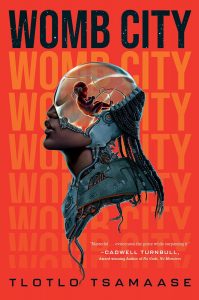Ian Mond Reviews Womb City by Tlotlo Tsamaase
 Womb City, Tlotlo Tsamaase (Erewhon Books 978-1-64566-056-9, $27.00, 416pp, hc) January 2024.
Womb City, Tlotlo Tsamaase (Erewhon Books 978-1-64566-056-9, $27.00, 416pp, hc) January 2024.
Tlotlo Tsamaase’s debut novel, Womb City, initially presents as science fiction. In an evocative opening, our protagonist Nelah tells us that ‘‘in our city, everyone lives forever. But murder hangs in the air like mist.’’ The city is Gaborone, the capital of Botswana. The mist is a ‘‘puff of human corpse-detecting chemicals’’ that can locate where a murder (rare though they are) has taken place. As for living forever, every citizen can transfer their consciousness into a new body. A lifespan consists of multiple body hops and is limited to 200 years. At that point, the consciousness is stored digitally, possibly for decades, before a new body is chosen. During that gap, the individual is robbed of their memory, meaning they can’t recall their previous lives.
Nelah is into her third lifespan. She is married to Elifasi, the assistant commissioner of the Gaborone police force. They have been trying to have a baby, but Nelah’s new body can’t bring a baby to term (‘‘I have given birth to three dead children’’). She’s also missing an arm and is microchipped, a sure sign that the body’s previous owner committed a crime. Elifasi holds the latter against Nelah, reminding her how lucky she is that he chose to marry her – very few men would. Despite this lopsided power dynamic, both are desperate to have a child. They turn to the Wombcubators: ‘‘minuscule oval spaceships hanging in deep-set alcoves’’ that provide constant care to fetuses. It’s expensive, but for Nelah and Elifasi, it’s worth the cost.
The novel takes on a noirish hue when we learn that Nelah is having an affair with Jan, the son of the wealthiest man in Botswana. It’s a significant risk, given that her microchip monitors her constantly, though one Nelah is willing to take because Jan accepts her for who she is: a successful woman who runs an award-winning architecture firm. But after a night of drugs and booze, Nelah collides with a young woman in her car, badly injuring her. Faced with the prospect of Elifasi finding out about the affair, Nelah is persuaded by Jan to kill the young woman – we later learn her name is Moremi – and bury her body. Noir blends into all-out horror when the following day, a guilty Nelah is overcome with terror when she spies Moremi’s corpse shambling down her street – a visitation only Nelah can see.
As much as I loved how the plot shifts under foot, I found the first third of Womb City hard going. At first, Tsamaase does a fine job laying out the building blocks of xer world: the rules regarding body-hopping, the reduction in crime, and the persistent monitoring of potential criminals. But frequent reminders regarding the regulations of body-hopping felt needlessly repetitive, interrupting the story’s flow. More concerning, at least in terms of worldbuilding, is the reported age of the characters – Nelah is 428, but there are the wealthy few who stretch beyond a thousand years – which doesn’t match when Womb City seems to be set. Tsamaase never provides a date for events, but based on the everyday technology we encounter – the mobile phones and fully automated cars and the sociopolitical forces at play – especially a fear of immigrants – the setting has a distinctly near-future flavour, no more than a century from now, indeed not enough time for a person to have lived multiple lifespans.
But following the collision and Moremi’s brutal death at Nelah’s hands, Womb City shifts gears. There’s less of a focus on explaining things and more an emphasis on the plot. I inhaled the second half of the novel, propelled by Nelah and Jan’s discovery of a century-old conspiracy – known as the ‘‘Murder Trials’’ – that reaches back to Botswana’s first ancestor: a giant, one-legged man who climbed out of a hole in a sandstone slab, leaving behind the Matsieng footprints. Even as the reveals come thick and fast, Tsamaase, with incandescent, furious prose, never lets us forget Womb City’s driving theme: how society, even so-called utopias, seek to disempower women and remove their bodily autonomy, to the degree they will fight amongst themselves for the few scraps of power that remain.
In an interview with Bookstr.com, Tsamaase said, ‘‘genres are worlds of their own, and when you blend different genres, you can expand one genre’s boundaries by intersecting it with another. It is empowering the universes you create out of that.’’ Womb City exemplifies this philosophy and much more.
Ian Mond loves to talk about books. For eight years he co-hosted a book podcast, The Writer and the Critic, with Kirstyn McDermott. Recently he has revived his blog, The Hysterical Hamster, and is again posting mostly vulgar reviews on an eclectic range of literary and genre novels. You can also follow Ian on Twitter (@Mondyboy) or contact him at mondyboy74@gmail.com.
This review and more like it in the December and January 2023 issue of Locus.
 While you are here, please take a moment to support Locus with a one-time or recurring donation. We rely on reader donations to keep the magazine and site going, and would like to keep the site paywall free, but WE NEED YOUR FINANCIAL SUPPORT to continue quality coverage of the science fiction and fantasy field.
While you are here, please take a moment to support Locus with a one-time or recurring donation. We rely on reader donations to keep the magazine and site going, and would like to keep the site paywall free, but WE NEED YOUR FINANCIAL SUPPORT to continue quality coverage of the science fiction and fantasy field.
©Locus Magazine. Copyrighted material may not be republished without permission of LSFF.








